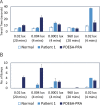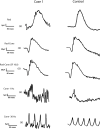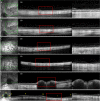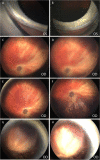Atypical chorioretinal lesions in Siberian Husky dogs with primary angle-closure glaucoma: a case series
- PMID: 35578341
- PMCID: PMC9109312
- DOI: 10.1186/s12917-022-03259-8
Atypical chorioretinal lesions in Siberian Husky dogs with primary angle-closure glaucoma: a case series
Abstract
Background: A number of etiologies for different canine chorioretinal lesions have been proved or suggested but some fundic lesions remain unclear in terms of an etiologic diagnosis, treatment options and prognosis. The purpose of this case series is to describe atypical chorioretinal lesions observed in dogs with primary angle-closure glaucoma (PACG).
Case presentation: Two spayed-female Siberian Huskies (3- and 4-year-old) and one Siberian Husky/Australian Shepherd mixed breed dog (11-month-old) that had multifocal depigmented retinal lesions and PACG were included.
Procedures: Ophthalmic examination, gross, and histopathologic examination findings are described. One of the dogs underwent further clinical diagnostics. Advanced clinical diagnostics on the fellow, presumed to be non-glaucomatous eye of a dog revealed: pectinate ligament dysplasia by gonioscopy, retinal thinning in the depigmented area and wedge shaped retinal thinning with delayed choroidal vascular perfusion by optical coherence tomography, confocal scanning laser ophthalmoscopy, fluorescein and indocyanine green angiography. Quantifiable maze testing for the same eye revealed mild nyctalopia but the full-field electroretinogram showed no generalized decrease of retinal function. Genetic testing for mutations within the retinitis pigmentosa GTPase regulator gene causing X-linked progressive retinal atrophy in Siberian Huskies was negative. Histopathologic evaluations on enucleated eyes in two dogs confirmed goniodysgenesis, PACG with optic nerve head cupping, and diffuse inner retinal atrophy. In addition, segmental profound retinal atrophy, loss of retinal pigment epithelium, and adhesion of the retina to Bruch's membrane was observed and coincided with multifocal depigmented lesions noted on fundic examination.
Conclusions: To our knowledge, this is the first case series with clinical and histopathologic data of chorioretinal lesions, most likely caused by severely impaired choroidal perfusion. Further studies are warranted to elucidate the etiology and pathophysiology, including its possible association with PACG.
© 2022. The Author(s).
Conflict of interest statement
The authors declare that they have no competing interests.
Figures












References
-
- Narfstrom K, Petersen-Jones SM, Gelatt KN, Gilger BC, Kern TJ, Ames IA. Veterinary ophthalmology. 5. USA: Wiley; 2013. Diseases of the canine ocular fundus; pp. 1303–1392.
-
- Genetics Committee of the American College of Veterinary Ophthalmologists . Ocular disorders presumed to be inherited in purebred dogs. 11. American College of Veterinary Ophthalmologists; 2018.
Publication types
MeSH terms
Grants and funding
LinkOut - more resources
Full Text Sources

